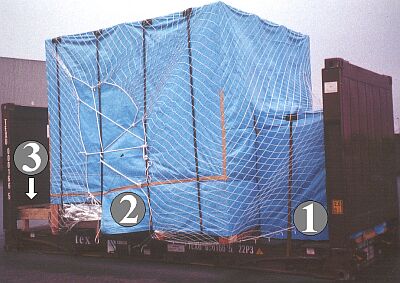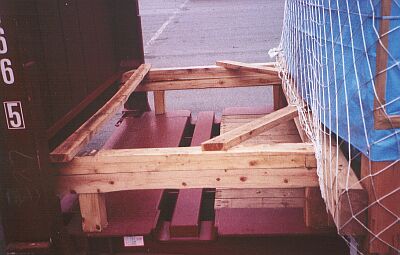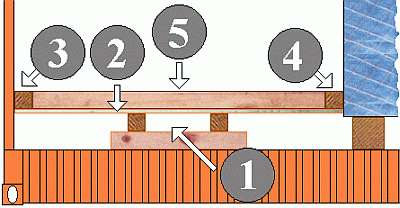Two cases of unequal weight on a 20' flatrack
The following example is basically positive.
 |
|
| Securing two cases on a 20' flatrack |
The case (1), which is neither overwidth nor overheight, is loaded tight against the end wall. The overheight and overwidth case (2) is positioned next to it. The gap between this case and the flatrack end wall is braced (3). The case's weather protection looks good - the case carries an umbrella as information mark and has consequently to be kept dry. The tear-resistant woven tarpaulin has been secured against wind with an additional net.
The steel strapping tie-down lashings all pass over edge protectors consisting of rubber tire segments, which ensures that their pretension is retained in transit. In addition, both cases have been positioned on strips of friction-enhancing material. Since case (1) had a very low mass and was clamped in place by the large case and the bracing, securing with only one tie-down lashing is tenable in this particular case.
It would have been still better if the large case had been placed on two case restraint shoes, which would have guaranteed a long-term lateral tight fit at floor level. If these had been used together with two tie-down lashings to secure against tipping, the securing arrangement could have been described as optimum.
 |
|
| Bracing at the end of the flatrack |
The wooden bracing is technically very well made. Nonetheless, it too could be improved upon.
 |
|
| Modified wooden bracing for filling the end wall gap |
Key to reference numerals:
(1) = base made of a crossover bed of wooden members or beams laid crosswise and lengthwise
(2) = boards fitted lengthwise
(3) and (4) = crosspieces at the ends of flatrack and case
(5) = bracing members fitted lengthwise